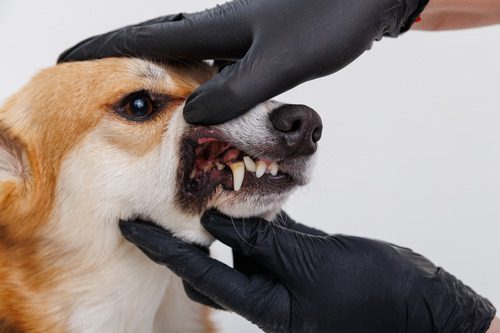Dental health often gets overlooked in routine pet care, but it can have a significant impact on a dog’s comfort, eating habits, and long-term well-being. One of the most common issues affecting dogs’ mouths is periodontal disease, a progressive condition that develops slowly over time. Learning about the different dog periodontal disease stages can help you recognize warning signs and take action before the condition worsens. Below, we’ll walk you through each stage, how it can affect your dog, and what you can do to support their oral health. If you’re in the Oakville area and have concerns about your dog’s teeth or gums, our team at Southeast Oakville Veterinary Hospital can help.

What Is Periodontal Disease in Dogs?
Periodontal disease in dogs is a progressive infection of the tissues that support the teeth, including the gums, ligaments, and jawbone. It starts with plaque buildup and can advance to painful tooth loss if not treated. This condition affects most dogs by the time they reach three years of age, making it one of the most prevalent health issues in canine companions. Bacteria from leftover food particles mix with saliva and form plaque. If plaque is not removed through regular brushing or dental cleanings, it hardens into tartar, which then irritates the gums and leads to inflammation. As the disease progresses, it moves deeper into the structures supporting the tooth.
Stage 1: Gingivitis
Gingivitis is the earliest stage of periodontal disease in dogs. At this point, only the gums are affected, and the damage is still reversible.
Signs of Stage 1 Gingivitis
- Slight redness along the gumline
- Mild swelling in the gums
- A thin line of plaque on the teeth
- Bad breath may begin to develop
At this stage, the bone and connective tissue around the teeth remain intact. However, the gums may bleed when touched or during brushing. Regular dental cleanings and improved home dental care can help manage plaque and reverse the early effects.
Stage 2: Early Periodontitis
In Stage 2 of dog periodontal disease, inflammation starts to affect the bone that supports the teeth. This stage involves more noticeable symptoms and requires professional intervention to prevent further damage.
Signs of Early Periodontitis
- Increased plaque and tartar buildup
- Gum recession (gums beginning to pull away from the teeth)
- More persistent bad breath
- Mild bone loss detectable on dental X-rays
The damage is no longer reversible, but with treatment, it can be managed and controlled. A veterinary dental cleaning under anesthesia is typically recommended to remove tartar and assess any deeper tissue involvement.
Stage 3: Moderate Periodontitis
Moderate periodontal disease in dogs means that infection has extended further into the supporting tissues and jawbone. By this stage, tooth stability may be compromised, and the condition can start causing discomfort or pain.
What Happens in Stage 3
- Gum pockets form between the teeth and gums
- Up to 50% bone loss may be visible on X-rays
- Teeth may start to shift
- Chewing may become painful, leading to changes in eating habits
- Inflammation becomes more pronounced
Dogs may start to favor one side of their mouth or drop food while eating. In some cases, owners might notice visible pus or excessive drooling. Dental surgery may be necessary to address deep pockets of infection, remove damaged tissue, and possibly extract unstable teeth.
Stage 4: Advanced Periodontitis
Stage 4 is the most severe form of dog periodontal disease. By this point, the infection has caused extensive damage to the gums, connective tissues, and bone.
Severe Signs of Advanced Periodontal Disease
- Loose or missing teeth
- More than 50% bone loss
- Severe gum recession and tissue destruction
- Visible tooth root exposure
- Oral pain and signs of systemic infection
Dogs in this stage often experience ongoing discomfort and may show signs of pain when eating, touching their face, or during play. In some cases, bacteria from the mouth can spread to the bloodstream and impact other organs such as the heart, kidneys, and liver. Treatment typically involves extractions, pain management, and a long-term dental care plan.
How Dental X-Rays Support Diagnosis
Veterinary dental X-rays are essential for evaluating the severity of periodontal disease. Much of the damage occurs below the gumline, where it can’t be seen during a visual exam. X-rays help detect bone loss, root abscesses, and the extent of damage surrounding each tooth. They are especially important during Stage 2 and beyond, when treatment decisions depend on what’s happening beneath the surface.
Preventing Dog Periodontal Disease
While periodontal disease is common, it’s also largely preventable. Daily home care and professional cleanings can make a big difference in your dog’s dental health.
Steps to Help Reduce Risk
- Brush your dog’s teeth daily with pet-safe toothpaste
- Offer dental chews or toys that help remove plaque
- Schedule annual or biannual dental exams and cleanings
- Monitor your dog’s breath, appetite, and gum appearance
Starting dental care when your dog is young helps them grow comfortable with brushing and makes it easier to maintain good oral hygiene into adulthood.
Why Early Detection Matters
Recognizing the early stages of dog periodontal disease allows for timely intervention and less invasive treatment. When caught early, professional cleanings combined with home care can stop the disease from progressing and improve your dog’s quality of life. Waiting too long can result in irreversible damage, pain, and costly procedures. Many dogs don’t show obvious signs of dental discomfort until the disease is advanced, so routine exams and cleanings are key. If you notice a change in your dog’s breath, eating habits, or gum color, contact Southeast Oakville Veterinary Hospital to schedule a dental evaluation.
Recent Posts
About Us
Southeast Oakville Vet offers a beautiful, state-of-the-art facility and is the only animal hospital in Canada that is AAHA accredited, Fear Free Practice Certified, and Cat-Friendly Practice Gold Certified. We continue to uphold these distinctions to support a lifetime of excellent health for your pets!
